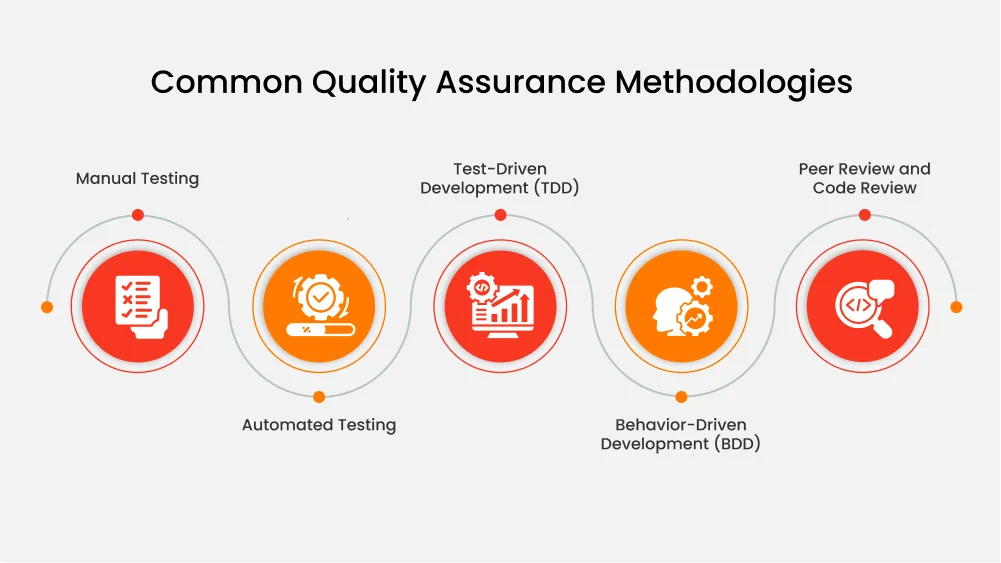
Quality Assurance in Software Development: How It Shields Your Product from Costly Failures
Let’s explore how quality assurance is not just a development formality, but a vital safeguard against failures, delays, and other post-release breakdowns.

Content Map
More chaptersIn any software development life cycle, testing and quality assurance are the two processes of vital importance to finalize outcomes and ensure only up-to-par products can make their way to end-users.
Even though both share the same goal of rolling out high-quality software, the software testing process is slightly different when its emphasis is on product functionality and performance, whereas quality assurance (QA) is about defect prevention to ensure the software passes all the predetermined quality standards and meets desired customer expectations.
Given the scope of an article, we specifically focus on the importance of software quality assurance. Let’s get started.
Key Takeaways:
Quality assurance (QA) plays an integral part in software development by ensuring the final product meets quality standards and user expectations. Its importance is underlined by several tangible benefits:
- QA minimizes defects, thus minimizing effort, resources, and costs.
- QA serves as a watcher to oversee and improve the entire software development process on multiple fronts, including quality, productivity, and efficiency.
- When implemented well, QA processes can speed up the SDLC and shorten the time-to-market of software products.
- Adherence to regulatory requirements or industry standards is crucial for software products, and QA plays a significant role in ensuring compliance.
- QA practices introduce quality metrics that serve as benchmarks for measuring product quality and performance, ultimately leading to better decision-making.
- Ultimately, the goal of QA is to deliver high-quality software products and maintain their quality as an ongoing effort.
What Is Software Quality Assurance (SQA)?
Without any further complication, quality assurance, commonly known as QA, typically involves a series of processes and systematic activities carried out to validate the product’s overall quality throughout the entire software development lifecycle (SDLC). Or you can think of QA as a gauge to measure how well a software application is developed and tested. Far from a mere checkpoint, QA in software development is a proactive defense mechanism that embeds quality into every stage of development.

What do we actually do in QA processes? Here are the primary activities involved:
- Requirement Analysis: The quality assurance team reviews and analyzes both functional and non-functional requirements to ensure they are all clear, complete, and testable. This phase involves close collaboration between the QA team and key stakeholders, such as product managers, business analysts, and developers. They join hands to define acceptance criteria and resolve any ambiguities or inconsistencies.
- Test Planning: Define the strategy and scope of the QA effort. The key outputs include the Test Plan document, which acts as a roadmap for the entire testing lifecycle and covers:
- Objectives and test scope.
- Types of testing (functional, regression, performance, etc.).
- Resource allocation (who will do what).
- Test schedule and deliverables.
- Risk assessment and mitigation strategies.
- Test Design: QA engineers design test cases, scenarios, and data based on requirements and user workflows. A traceability matrix is also created to ensure full coverage and alignment with business goals.
- Test Design: QA engineers design test cases, scenarios, and data based on requirements and user workflows. A traceability matrix is also created to ensure full coverage and alignment with business goals.
- Environment Setup: A dedicated test environment is prepared to replicate production conditions, including hardware, software, data, and automation tools. The setup is validated before testing begins.
- Test Execution: In the testing phase, QA teams execute test cases manually or via automation, logging actual vs. expected results. Failures are documented for analysis and resolution.
- Defect Tracking: Identified defects are logged with detailed information such as steps to reproduce and severity. QA works closely with developers to track, prioritize, and retest fixes.
- Test Reporting: Test reports summarize execution results, defect statistics, coverage levels, and release readiness. These insights support informed decision-making by stakeholders.
- User Acceptance Testing (UAT): UAT is conducted by end users to verify that the system meets business needs and is production-ready. It helps catch usability and domain-specific issues before release.
- Release Management: QA verifies build stability and conducts final checks before release, coordinating with DevOps and documenting release notes. This ensures a smooth and reliable deployment.
- Post-Release Monitoring: This phase involves continuous monitoring and system testing after launch. The QA team proactively observes and evaluates how the software performs under real-world conditions, not just in controlled test environments. Insights such as user-reported issues, system performance metrics, and crash reports are gathered to inform future improvements and enhance overall user satisfaction.

SQA is not an independent task but an integrated part that functions in parallel with almost every step of the software development lifecycle. It is a ongoing process that begins from the very initial planning stage until the software product is released and maintained.
Software quality assurance ensures that the required quality standards are complied with, and continuous improvement is maintained throughout the SDLC. It oversees the whole process of developing software in order to detect defects from within and provide the development team with ways for enhancement. Note that QA is responsible for the overall software quality management system rather than focusing on only an end product or service.
The Benefits of Robust Software Quality Assurance Processes
A software development process stands a little chance of success without an effective quality assurance system. In regard to product quality, there is no shortage of reasons to emphasize the impact of QA processes in software engineering or development. Needless to say, a sub-par product is suitable for users, but the ramifications of releasing a low-quality software product go far beyond that.
Fewer Defects, Fewer Costs
QA processes offer cost savings in development.
From the term itself, QA ultimately aims to minimize the occurrence of defects or bugs in the entire development process. If software engineers and the QA team do it effectively, they can identify the root cause of issues in early phases (E.g., design or coding) and address them before they infiltrate deeper layers of the product.
This proactive approach results in fewer problems in the later stages and post-release. Consequently, your professionals can spend less time and resources on emergency fixes and extensive tests. In software engineering, saving time translates into reduced development costs.

Additionally, bugs and errors in the later development phases are often more costly or even catastrophic to rectify than those found at an earlier stage. The cost and time of fixing bugs increase exponentially the later they are discovered. Those identified after deployment may require system-wide changes or urgent patches, sometimes even leading to widespread software failures or financial losses. By applying proper testing procedures and QA practices, you can avoid these problems.
However, it is a common misconception that QA ensures high quality products. This is not entirely accurate. Quality assurance focuses on verifying that the software meets specified requirements and behaves as expected. It does not judge whether a product is “good” in a broad or subjective sense, but rather ensures that it conforms to agreed-upon standards and specifications.
Uncovering Weaknesses in Current Processes and Procedures

SQA centers on upholding the integrity of the entire development process, beyond simply testing code or just the end product. Through continuous monitoring workflows, analyzing testing outcomes, and reviewing quality checkpoints, QA professionals can uncover hidden inefficiencies that may otherwise go unnoticed. For example, communication breakdowns, inadequate documentation, and poor task coordination across teams.
Once identified, such issues can be collaboratively addressed before they progress and compromise development velocity, budget, or quality. In this way, SQA contributes to overall risk management, minimizing uncertainty and enabling early course correction when problems emerge.
Accelerating Product Delivery

A well-structured QA strategy also contributes to an on-schedule release. When quality assurance is embedded early and consistently throughout development, it reduces the need for time-consuming rework, bug fixing, or redundant testing. Software developers can shift their focus to core functionality and innovation rather than firefighting defects at the last minute.
Also, an optimized QA test plan in place can help QA professionals and the software development team improve collaboration and coordination as well as work in harmony. Also, an optimized QA test plan not only helps avoid launch delays but also maintain development momentum. Ultimately, QA in software development leads to a faster turnaround and a smoother path to release without sacrificing product quality.
Ensuring Compliance with Industry Standards

In heavily regulated sectors (E.g., finance, healthcare, or aviation), compliance is non-negotiable. Failure to comply with industry-specific standards results in legal penalties, loss of trust, and reputational damage. The comprehensive QA processes warrant that the developed software adheres to relevant regulatory requirements and standards, such as ISO, GDPR, HIPAA, or SOX. QA in software development is not merely about quality but also about credibility, reliability, and user confidence.
Establishing Software Quality Metrics

When supported by a well-defined QA strategy, software engineering processes tend to be more data-driven than those that lack one. It introduces software quality metrics, such as code coverage, code churn, defect density, bug resolution time, or number of critical bugs in production. These serve as quantifiable benchmarks that allow development teams to assess progress, detect problems, and make data-driven improvements throughout the software project lifecycle.
Optimal Product Quality & Reliability

All these QA advantages converge on one ultimate goal: Deliver a high-caliber software product. Whether it is a mobile application, SaaS platform, enterprise tool, or backend service, users expect functionality, consistency, and trustworthiness. QA processes uphold these expectations through rigorous testing and validation, and continuous monitoring, maintaining quality as an ongoing effort.
Common Quality Assurance Methodologies
Now that we have emphasized the importance of quality assurance processes in software development, let’s delve into common systematic approaches and techniques. These are implemented in different combinations (multi-testing strategy) depending on the specific project and team needs.

Manual Testing
Manual testing is a fundamental aspect of any QA process. It involves human testers executing test cases and scripts manually. No automated testing tool is used to identify defects or bugs in the software product. The test results also reveal the weak points within the development process itself.
Manual testing is particularly useful for small projects with limited resources or those with new functionalities that continuously evolve or cannot be automated. Some of the commonly used manual testing techniques include:
Exploratory Testing
Experimenting with the application with different scenarios and inputs, and identifying defects through creative and critical thinking.
Ad-Hoc Testing
Executing test cases with any predefined plan or script in a more informal and unstructured manner (Relying on the tester’s intuition and experience).
Regression Testing
Ensuring the correct behavior of a previously tested software system after it has been modified. Regression testing is done to guarantee that changes or enhancements made to a piece of software or its test environments, such as upgrading components or fixing bugs, do not introduce new problems.
User Acceptance Testing (UAT)
Validating that the software meets its design and satisfies all functional requirements from the end-user perspective. UAT can be created by testers, business analysts, developers, or users who are familiar with the system. If the customer has not been involved in creating functional specs before this point, it is usually best to have them validate the system.
Smoke Testing
Preliminary testing checks the basic functionality of the software before proceeding to more detailed testing.
Automated Testing
As opposed to manual tests, automated tests are conducted with the use of specialized automation tools and frameworks. Indeed, it is a fast and cost-effective method of detecting bugs and errors in developed software. Not only does it speed up the process and save time as well as effort, automated testing enables to prioritize more complex tasks that require human intelligence.
Unit Testing
Verify if individual components or units of a software product function as expected. Unit testing is usually conducted by developers during the development phase and involves testing small, isolated units of code. Often automated using frameworks like JUnit or NUnit.
Integration Testing
Evaluating how different modules or services interact and whether any defects arise from their interaction. This testing can be done manually or with the use of automation tools that simulate various integration scenarios, such as Selenium or Protractor.
Security Testing
Software security testing checks if the software process remains secure throughout its execution. It tests areas of software where vulnerabilities could be present to attempt to exploit the system by attacking it. A few security testing examples include:
- Penetration Testing: Test a system and its features (usually through automated means) to determine if vulnerabilities exist and can be exploited.
- Secure Coding: Make sure that all security information (including passwords) is encrypted, not stored in plain text, and hashed appropriately.
Functional Testing
Test and ensure each function of a software product operates in conformance with the requirement specification. Automation tools like Selenium and Cucumber can automate repetitive functional tests.
Performance Testing
Assessing how a system performs under specific circumstances. For example, high workload or heavy usage. Such tests evaluate response times, throughput, resource utilization, and stability of an application under load. Performance testing is usually automated using specialized tools (E.g., Meter or LoadRunner).
- Stress Testing: To put a software system under extreme workloads to check whether it can handle the increased load.
- Load Testing: Evaluate system performance under both expected and peak load conditions. This test identifies the maximum number of users an application can handle before showing signs of strain.
- Endurance Testing: Validate long-term usage and evaluate the system’s capability to handle sustained traffic.
- Spike Testing: Analyze the software’s performance when the workload suddenly increases drastically.
Test-Driven Development (TDD)
This is a software development methodology that heavily relies on writing tests before any actual code is created. The TTD process is to facilitate early testing and guarantee that the code meets the requirements and functions. TDD can be implemented at all levels of testing (unit, functional, integration, etc.) and promotes continuous testing throughout the development cycle.
Behavior-Driven Development (BDD)
This is an extension of TDD that focuses on testing behavior rather than specific features or outcomes. BDD uses a format called “Gherkin” to write tests in a natural language using keywords like Given, When, and Then so that even non-technical stakeholders can understand. BDD encourages collaboration between developers, testers, and business analysts to ensure that the tests reflect the desired behavior of the software product.
Peer Review and Code Review
It is like cross-checking that the developed software meets specific coding standards and is error-free. Code reviews involve a team member going through the code written by another team member to identify any issues, bugs, or inefficiencies. In peer reviews, two developers are paired together to check each other’s code as it is written. Apart from catching errors early on, these reviews provide valuable feedback and promote knowledge-sharing and collaboration within a team.
Quality Assurance Vs. Quality Control: What’s the Difference?
QA and QC are considered close cousins, as their natures are nearly identical. Both watch over the quality management aspect of software development processes. Still, they differ in many ways. The following table will help you understand the nuances of QA and QC:
| Parameter | Quality Assurance (QA) | Quality Control (QC) |
|---|---|---|
| Definition | Oversee the whole process of developing software to ascertain the quality of end products or services. | Conduct checks and take corrective measures to ensure an end product or service adheres to quality requirements. |
| Focus | Process-oriented. Focus on methods, procedures, and systems of creating the product. | Product-oriented. Inspect and test the final product to ensure it meets the requirements. |
| Objective | Prevent defects by enhancing development processes | Identify and correct defects in finished products |
| Activity | Documentation, project audits, process design, training | Product testing, defect logging, reviews, and corrections |
| Timing | Throughout the development phase. QA is conducted prior to QC. | After product development is completed. |
| Responsibility | Involves all teams | Typically handled by a QC team |
| Outcome | Processes are followed correctly. | The end products meet the specified requirements. |
Partner with Orient Software to Stay Ahead of the Future of Quality Assurance
It is predictable that the tech landscape will continue to evolve, and there is no indication that it will slow down. Given that, we have every reason to believe that the role and execution of software quality assurance will continue to transform. Driven by AI integration and automation as well as the soaring demand for continuous delivery, QA will no longer be confined to a reactive, post-development phase. Instead of that, it becomes a strategic, embedded discipline with a focus on preventing issues early and ensuring quality at every stage of the SDLC.
For many businesses or projects, especially those with limited in-house expertise or resources, navigating the complexities of modern software QA can be a daunting task. That’s when they can take a shortcut by outsourcing SQA processes to capable hands rather than struggling with the complexities on their own.

Orient Software has elite professionals to help streamline your development processes and elevate product quality through our deep expertise in quality assurance testing, DevOps, and product engineering. Whether you need QA consulting, test automation, or a dedicated development team, we provide tailored solutions to match your goals. Our team of highly skilled developers, QA engineers, testers, and other IT professionals is carefully vetted to ensure technical excellence and smooth collaboration. You can rely on us to build a high-performance team that works exclusively for you.
At Orient Software, we deliver results, not just promises. Let’s discuss how we can support your project with quality, speed, and confidence.






